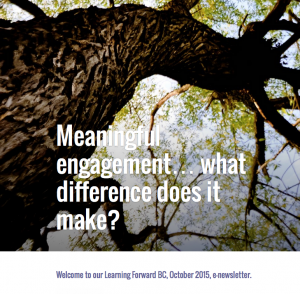
Welcome to LFBC Fall 2018, Engagement is still important, what do we know now that we did not know in 2015?
Collaborative Professionalism:
High trust and deliberate design required!
A LEADERSHIP REFLECTION
Ever wished that group members feel empowered to speak their mind, especially when they may be challenging the status quo? In Becoming a Learning System [Hirsh, Psencick and Brown], trust is defined as the connective tissue that allows us to question current practices and take risks to try new strategies. Inspiring trust is discussed as a core aspect of building a learning system. “Leaders create trust when others see that the leader’s actions are congruent with the leader’s words, eliciting the feeling that the leader is sincere and authentic [p. 93].” Consider the following of yourself and other leaders:
- Do you ensure that your trustworthiness by intentionally focusing on honesty, sincerity, competence, reliability and benevolence?
- Do you take seriously the way others view you and recognize how your actions affect you and others?
- Do you regularly remind yourself of the coherence of your body, language and emotions?
- Do you make clear declarations, requests, and offers so that staff members know what work is expected of them, and can you develop strategies to achieve those expectations?
- Do you routinely demonstrate the power of presuming positive intentions?
LEADERSHIP IN ACTION
At our summer affiliate meeting in Portland, there was an important conversation regarding the Learning Forward Standards for Professional Learning. I was elated when an American affiliate shared an opinion that we, as a Canadian Affiliate, have been discussing – the use of the term professional learning standards! The open conversation that followed was reassuring, especially since the Canadian Study on the State of Professional Learning has propelled Canadian Affiliates to endorse a preference for using the term framework, elements or characteristics of professional learning. The structure of the conversation and the fact that trust had been developed at our table, and in the room, provided the conditions for a collaborative conversation that substantiated our work as a Canadian Affiliate to be recognized for our point of view. I believe that we are in a stronger place to move forward with the Canadian Framework on professional learning [insert link].
In our affiliate work, I have been curious to explore how trust is embedded in cross role collaborative teams. In a summary of Leading Collaborative Professionalism, Andy Hargreaves and Michael T O’Connor discuss the difference between professional collaboration and collaborative professionalism. In their exploration of five different designs for teacher collaboration in different parts of the world, the reader is invited to consider the Quadrants of Collaboration [p. 5] in which the level of trust interfaces with the structure, tools and precision in work organization. High trust and high precision are required for authentic collaborative professionalism. Hargreaves comments that this is “rooted in deep relationships combined with deliberate design.” The discussion of collaborative professionalism, “an advanced organizer about how teachers and other educators transform teaching and learning together to work with all students…” provides a rich insight into how we can work together effectively in order to collaborate more deeply, to achieve greater impact.
If you wish to create collaborative professionalism culture in your learning system, I invite you to read these two resources to inform and enhance your practice.
Comments are closed.